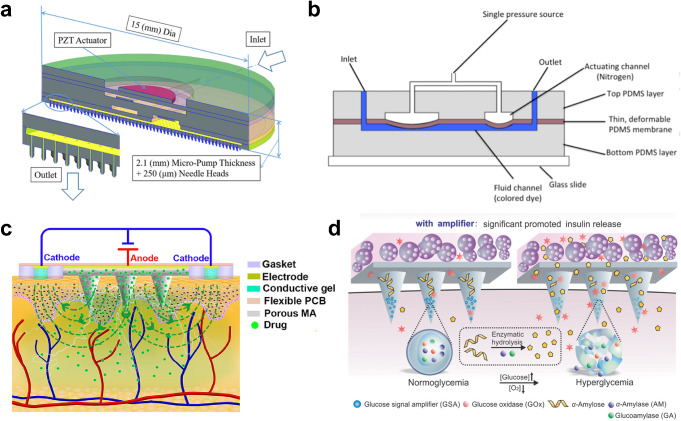Fig. 4.
Technologies enabling active delivery of insulin across the skin compatible with a microneedle array-based system. a. A silicon-glass-PDMS-lead zirconate titanate (PZT) piezoelectric micropump integrated with a hollow microneedle array [123]. b An insect-mimetic, pulse-driven mechanical microfluidic pump from Chatterjee et al. [192, 193]. Zhang et al. (2022) later coupled the system with a 3D-printed hollow microneedle array [120]. c A hydrogel-based iontophoretic system that helps deliver insulin across the skin coupled with a porous microneedle array [133]. d A system that contains pancreatic islets that actively secrete insulin, as well as a dissolving microneedle array containing glucose signal amplifiers (GSA) including GOx, α-amylase (AM), and glucoamylase (GA) for glucose-sensitive insulin delivery [119]. (a) Reproduced from Meshkinfam F, Rizvi G. A MEMS-Based Drug Delivery Device With Integrated Microneedle Array—Design and Simulation. J Biomech Engi. 2021;143:081010 [123]. Copyright permission from American Society of Mechanical Engineers (ASME). (b) Reproduced from Chatterjee K. Analytical and Experimental Investigation of Insect Respiratory System Inspired Microfluidics: Virginia Tech; 2018 [192]. Copyright permission from Virginia Tech Libraries. (c) Reproduced from Li Y, Yang J, Zheng Y, Ye R, Liu B, Huang Y, Zhou W, Jiang L. Iontophoresis-driven porous microneedle array patch for active transdermal drug delivery. Acta Biomater. 2021;121:349–358 [133]. Copyright permission from Elsevier. (d) Reproduced from Ye Y, Yu J, Wang C, Nguyen NY, Walker GM, Buse JB, Gu Z. Microneedles Integrated with Pancreatic Cells and Synthetic Glucose-Signal Amplifiers for Smart Insulin Delivery. Adv Mater. 2016;28:3115–3121 [119]. Copyright permission from Elsevier

